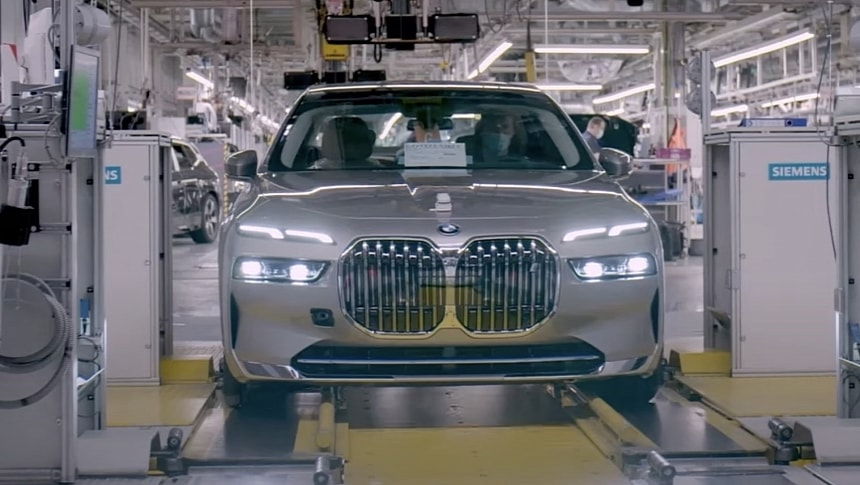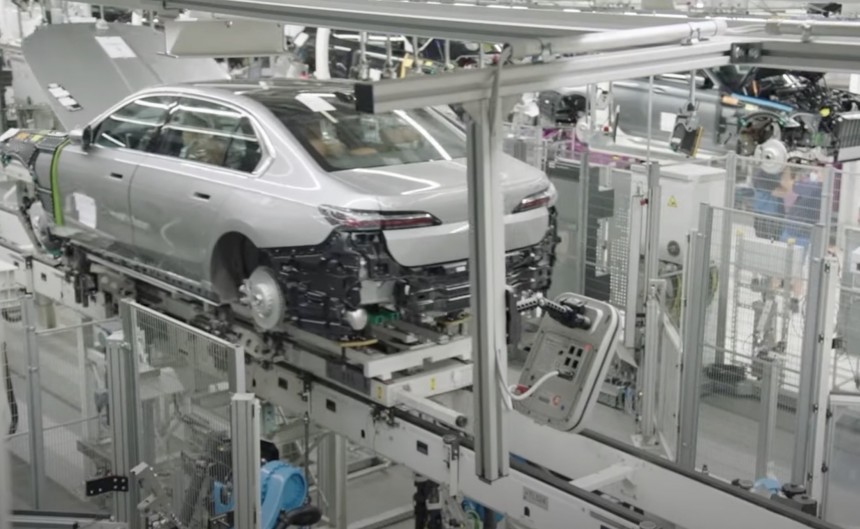BMW debuted the seventh generation of the BMW 7 Series (G70) back in 2022 both as an ICE and as an electric vehicle, for the first time, in the shape of the i7. Both of them roll off the production line in Dingolfing, Germany.
BMW officially unveiled the G70 on April 20, 2022, to mark the nameplate's 45th anniversary. Underpinned by the CLAR architecture, the model entered production on July 1, exactly seven years after the previous generation, at BMW's Dingolfing plant in Germany, and went on sale in the fall of 2022.
There is no longer a V12 in the lineup. All engines feature a mild-hybrid system, while BMW also offers a plug-in variant, the M760e. All versions are built on the same production line.
Building cars since 1973, the Dingolfing plant, located in southern Bavaria, is BMW's largest in Europe. Around 18,500 people work in the facility that covers 2.8 million square meters (30 million square meters). That is where the automaker also builds the 4 Series, 5 Series, 6 Series, 7 Series, 8 Series, and iX. Approximately 292,000 cars drive through the factory gate every year, which means 1,500 are completed every day.
To get the production facility ready for the production of the new-generation 7 Series and convert production lines, BMW invested more than 300 million euros ($319 million at the current exchange rates).
The assembly process is fully automated. Robotic arms position and weld the chassis and bodywork components. Every vehicle is moved around the factory with the help of several conveyor belts, lifting platforms, and rail-guided ceiling cranes.
The facility can produce components for more than 500,000 electric cars per year. For the i7 and for the plug-in hybrid, powerful electric control units (ECU) are required to manage the additional electronic elements.
Every task is carried out with precision. For instance, when assembling plastic and metallic components, bolts must be tightened carefully to avoid unwanted deformations or cracks.
Human workers install the interior components with the help of lifting arms and aiding machines. Putting robots next to humans along the assembly line is a combination that allows the automaker to carry out a flexible manufacturing process while building cars with different characteristics. The procedure enhances safety of the workers and reduces their physical effort.
Vehicles travel along a conveyor belt through various assembly stations. Workers can step on the belt to move along with the car to make sure everything is properly installed. Wheels are fastened using five bolts that must be tightened following a star pattern, which ensures the correct wheel alignment.
Furthermore, some of the most damage-prone bodywork components, such as the front and rear bumper, are specifically designed to be easily fitted and removed in case they need to be replaced.
When every component is in place, every BMW 7 Series or i7 undergoes tests, which are run to ensure the safety and proper functioning of each vehicle. Wheel alignment, electric insulation, and voltage level are all checked in a final inspection before the luxury sedans drive through the factory gate.
There is no longer a V12 in the lineup. All engines feature a mild-hybrid system, while BMW also offers a plug-in variant, the M760e. All versions are built on the same production line.
Building cars since 1973, the Dingolfing plant, located in southern Bavaria, is BMW's largest in Europe. Around 18,500 people work in the facility that covers 2.8 million square meters (30 million square meters). That is where the automaker also builds the 4 Series, 5 Series, 6 Series, 7 Series, 8 Series, and iX. Approximately 292,000 cars drive through the factory gate every year, which means 1,500 are completed every day.
To get the production facility ready for the production of the new-generation 7 Series and convert production lines, BMW invested more than 300 million euros ($319 million at the current exchange rates).
BMW builds the electric drive components in-house
BMW assembles the i7 sedan's electric drive components in-house at Dingolfing. The battery and the integrated electric drive system are manufactured at BMW's Competence Center for e-Drive Production before they are mounted to the car.The facility can produce components for more than 500,000 electric cars per year. For the i7 and for the plug-in hybrid, powerful electric control units (ECU) are required to manage the additional electronic elements.
Every task is carried out with precision. For instance, when assembling plastic and metallic components, bolts must be tightened carefully to avoid unwanted deformations or cracks.
Human workers install the interior components with the help of lifting arms and aiding machines. Putting robots next to humans along the assembly line is a combination that allows the automaker to carry out a flexible manufacturing process while building cars with different characteristics. The procedure enhances safety of the workers and reduces their physical effort.
Vehicles travel along a conveyor belt through various assembly stations. Workers can step on the belt to move along with the car to make sure everything is properly installed. Wheels are fastened using five bolts that must be tightened following a star pattern, which ensures the correct wheel alignment.
Furthermore, some of the most damage-prone bodywork components, such as the front and rear bumper, are specifically designed to be easily fitted and removed in case they need to be replaced.
When every component is in place, every BMW 7 Series or i7 undergoes tests, which are run to ensure the safety and proper functioning of each vehicle. Wheel alignment, electric insulation, and voltage level are all checked in a final inspection before the luxury sedans drive through the factory gate.







